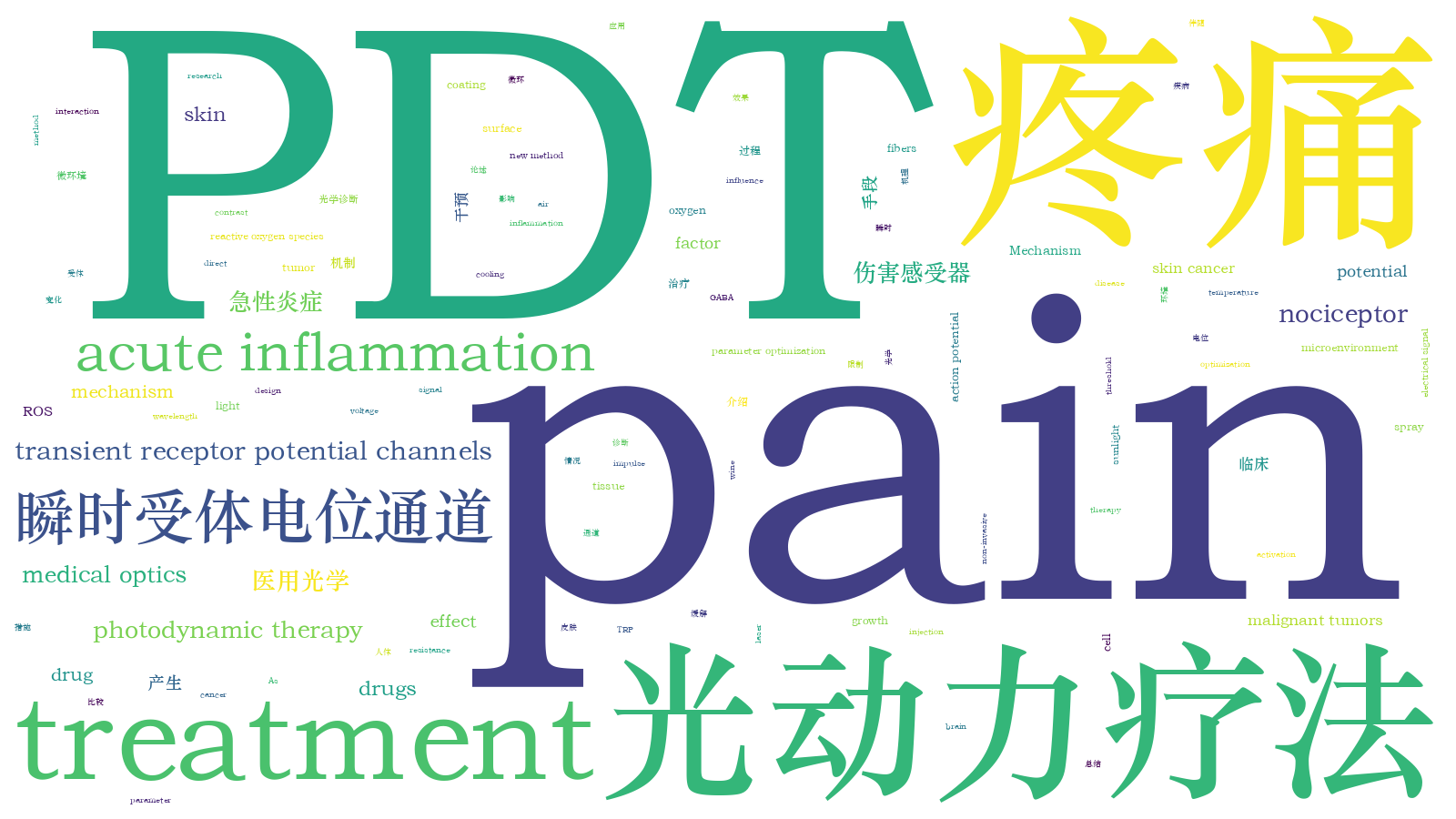光动力疗法产生疼痛的机制以及临床干预手段  下载: 590次
下载: 590次
Photodynamic therapy (PDT) is a new method that uses cytotoxic reactive oxygen species (ROS), which are generated through the interaction of oxygen in tissues and photosensitizers excited by the light of a specific wavelength, to erode the nidus. Currently, PDT has been approved by the Food and Drug Administration (FDA) for the clinical treatment of skin diseases (such as superficial skin cancer, actinic keratosis, squamous cell carcinoma, basal cell carcinoma, port-wine stains, and malignant tumors) and malignant tumors (such as esophageal, gastric, and lung cancers). Compared with traditional treatment methods, PDT has the following advantages: it results in highly selective tissue destruction, is non-invasive, has low side effects, is with no obvious drug resistance, and is easy to combine with other treatment methods.
In the clinical practice of treating skin diseases, patients experience burning, tingling, or pain during treatment with PDT. In contrast, in the treatment of malignant tumors, patients rarely report pain because they are treated with PDT under general anesthesia. The discomfort experienced during PDT often influences the treatment, greatly reducing the efficacy of PDT; some patients even cease the treatment because of the excruciating pain. Figuring out the mechanism of pain during PDT is of great importance because researchers and clinicians can develop targeted drugs and design interventions according to the mechanism.
At present, the underlying mechanism of pain during PDT has not been fully elucidated even though the mechanism of pain and changes in the microenvironment caused by PDT have been well studied. In short, the mechanism of pain is explained as follows (Fig. 1). After the tissue is subjected to a specific physical or chemical stimulus, the primary afferent nociceptor converts the painful stimulus into an electrical signal by opening ion channels such as the transient receptor potential vanilloid 1 (TRPV 1) and transient receptor potential ankyrin 1 (TRPA 1). Subsequently, a large influx of calcium ions occurs, the cumulative voltage change results in an action potential in the damaging fibers, and the electrical signals travel from these fibers to the cerebral cortex, where they are perceived as pain. The TRPV 1 and TRPA 1 ion channels are expressed abundantly on the skin surface. When PDT is performed, the light and ROS can stimulate the TRP channels and cause the original potential change and subsequently produce a sense of pain. As for the changes in the microenvironment, an acute inflammation occurs after PDT, and cytokines such as histamine, glutamate, prostaglandin, 5-hydroxytryptamine, substance P, nerve growth factor, and tumor necrosis factor-α are generated, binding to receptors such as α-amino-3-hydroxy-5-methyl-4-isoxazole-propionic acid receptor (AMPA), N-methyl-D-aspartic acid receptor (NMDA), γ-aminobutyric acid (GABA), neurokinin 1 receptor (NK1R), nerve growth factor receptor (NGFR), and tumor necrosis factor receptor (TNFR), which then cause a nerve impulse (Fig. 2).
Various clinical interventions have been applied to manage pain during PDT (Fig. 3), such as drug coating, intravenous injection, inhalation, scalp nerve blocks, treatment site cooling with cold air or water spray, treatment parameter optimization, and sunlight PDT. However, the efficacies of these interventions differ (Table 1): some drug interventions, such as oral drug and facial coating, cause no obvious pain-relieving effect during PDT, while the pain-relieving effect of some other drug interventions, such as intravenous drugs, depends on the treated disease and analgesic type. Unexpectedly, physical interventions (mainly referring to water spray) have a great pain-relieving effect during PDT. This intervention is now chosen by most clinicians because it does not require additional drugs, has minor side effects, and does not influence the therapeutic effect. A reasonable explanation is that by decreasing the temperature of the surface of the skin, the activation threshold of the TRPV 1 channel is lowered, and the original nerve impulses are not easily produced. Therefore, the interventions for targeting the TRP channels are effective to reduce the pain of patients during PDT treatment. Nevertheless, this intervention requires additional instruments, which are not allowed in most hospitals.Therefore, it is promising for researchers or clinicians to develop more targeted drugs or interventions for TRP channels to relieve pain generated during PDT.
In clinical practice, PDT has been widely applied to cure various skin diseases; however, patients always experience excruciating pain and often discontinue the treatment. The main reason for the pain is that PDT has a direct effect on nerve endings by directly stimulating TRP channels. The laser used in PDT directly activates the TRPV1 and TRPA1 channels, causing nerve impulses that eventually send signals to the brain and result in pain. In addition, large amounts of ROS produced locally during PDT can irritate the TRPV1 and TRPA1 channels, causing acute pain. However, at present, there are no clinical intervention measures or drugs targeting the TRPV1 and TRPA1 channels, which are very valuable directions of research on relieving pain generated during PDT.
雷栋钦, 刘晶, 张镇西, 曾维惠, 姚翠萍. 光动力疗法产生疼痛的机制以及临床干预手段[J]. 中国激光, 2023, 50(9): 0907206. Dongqin Lei, Jing Liu, Zhenxi Zhang, Weihui Zeng, Cuiping Yao. Mechanism of Pain in Photodynamic Therapy and Clinical Interventions[J]. Chinese Journal of Lasers, 2023, 50(9): 0907206.







